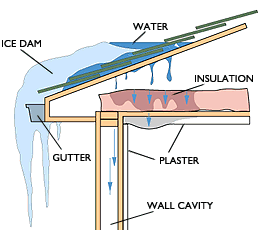Ice Damming
Facts About Ice Damming in Erie, CO
If your home has a steeply sloped roof and is more than 20 years old, there is a 98 percent probability that your attic has excessive heat, leading to ice damming. This can result even in newly constructed homes that may have serious attic heat problems. Most people attribute the problem of ice damming to the roof or gutters saying the roofer caused it, but this may not be the case. Even if a roofing contractor properly installed your roof there still may be ice damming and water leakage – not from unsatisfactory roofer or gutter workmanship, but rather as a result of one of several subtle sources of heat.
Excessive Attic Heat
How does heat enter the attic? How does heat exit in the attic? These are two very important questions that must be asked for every construction design, whether it is for new construction, additions, or renovations. Without heat, there are no ice dams, no moisture condensation problems, and no health issues. The rule of thumb is that properly ventilated attic air should never be more than 15 degrees hotter than the outside air. If it is hotter, then that is an indication of additional heat sources that should be eliminated and/or an indication of unsatisfactory attic ventilation that must be corrected immediately.
Snowmelt of an attic without excessive heat build-up and with functional attic ventilation should be totally and uniformly white. If the snowmelt were the result of heat from the sun, all of the roofs would be clear, without any white spikes on the roof being present. Attic heat is the enemy of all roofs, and poses a problem for the insulation, HVAC systems, and health factors, too. Using 12 inches of insulation, creating an R-38, is optimal. Remember, only have one vapor barrier and install it facing toward the heated surface. If additional layers of insulation are needed to attain 12″, use either unfaced insulation or blown-in insulation. Airflow is easily explained using a ketchup bottle as an example. When you open a new bottle of ketchup and turn it over, the ketchup does not immediately come out. In order for the ketchup to exit the bottle, air must enter the bottle and occupy the space just left by the ketchup. The same scenario holds true for your attic. In order for heated attic air to exit the attic, make-up air must be able to enter the attic. Having only inlet vents, or having only outlet vents in a balanced proportion.

REQUEST A FREE QUOTE
